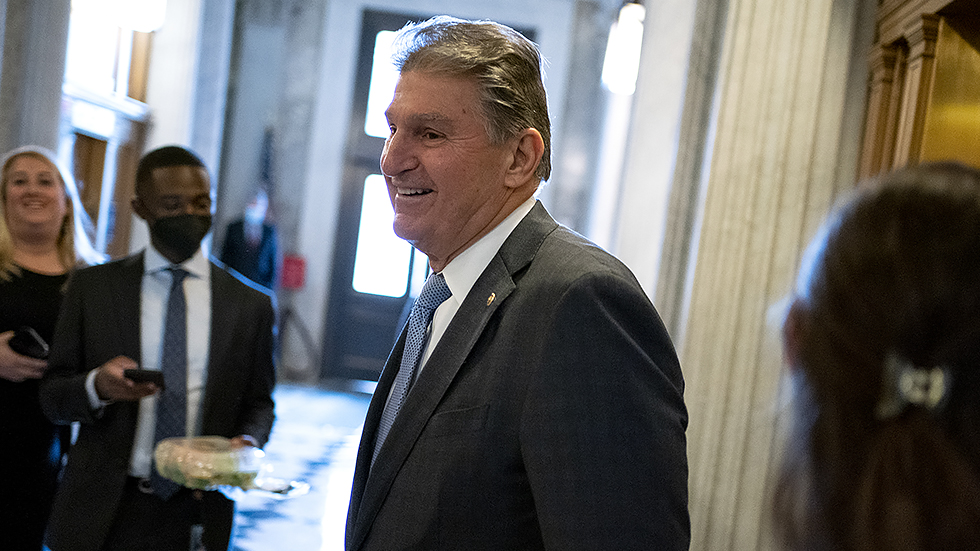Overnight Energy & Environment — Presented by ExxonMobil — Biden sets government net-zero date of 2050
Welcome to Wednesday’s Overnight Energy & Environment, your source for the latest news focused on energy, the environment and beyond. Subscribe here: digital-staging.thehill.com/newsletter-signup.
Today we’re looking at a new executive order on emissions from the federal government, the latest from Sen. Joe Manchin (D-W.Va.) on the methane fee and the environmental details in the final text of the National Defense Authorization Act.
For The Hill, we’re Rachel Frazin and Zack Budryk. Write to us with tips: rfrazin@digital-staging.thehill.com and zbudryk@digital-staging.thehill.com. Follow us on Twitter: @RachelFrazin and @BudrykZack.
Let’s jump in.
Biden signs net-zero by 2050 order

President Biden on Wednesday signed an executive order that directs the federal government to achieve net-zero carbon emissions by 2050.
The order also directs the federal government to use its purchasing power toward a goal of 100 percent carbon-free electricity by 2030, which is five years ahead of the administration’s target of 2035 for national carbon neutrality. It further directs the government to ensure demand is met by making at least half of that energy locally produced.
Under the order, the federal government would also reduce its operating emissions by 65 percent by 2030. This is also more ambitious than the administration’s stated goal of cutting emissions by half nationwide by 2030. However, the 2050 date for full carbon neutrality within the federal government matches the administration’s goal for nationwide net-zero emissions.
What else? Senate Environment and Public Works Committee Chairman Tom Carper (D-Del.) praised the order in a statement Wednesday afternoon, calling it “the right thing to do.”
The order “will move us closer to reaching our shared climate goals and strengthen our clean energy sector” as well as “enhance the implementation of our recently enacted bipartisan infrastructure bill, meaning more Americans getting to work in good-paying jobs,” Carper said in a statement.
The Delaware senator went on to say cooperation from states will be necessary to achieve the goals outlined in the order.
Read more about the order here.
A MESSAGE FROM EXXONMOBIL
Carbon capture and storage. One way we’re helping reduce emissions.
Industry and power generation account for nearly two-thirds of global CO2 emissions. At ExxonMobil, we’re collaborating on some of the world’s largest carbon capture and storage projects to help reduce industrial emissions at scale.
Manchin sees progress on methane fee

Sen. Joe Manchin (D-W.Va.) expressed some degree of openness to the latest iteration of Democrats’ proposed program to cut methane emissions from the oil and gas sector on Wednesday, telling reporters that “good adjustments” have been made.
“They’re working through that. I think they made some good adjustments on it,” said Manchin, a key Senate swing vote, when asked about the program.
But he suggested that some aspects are still under discussion.
Such as? “You’ve got to do one of two things. Do you want basically different things through regulations as far as EPA [Environmental Protection Agency], or do you want money? If they’re basically complying with the regulations, then you shouldn’t be subject to a fee, so we’re talking about different things like that,” Manchin said.
Methane is a planet-warming gas that is 25 times more potent than carbon dioxide over a 100-year period. In 2019, it made up about 10 percent of the country’s contribution to climate change.
Democrats have proposed a fee under which oil and gas companies would be fined for their excess emissions of the gas in their climate and social spending bill.
Read more about Manchin’s comments here.
CLIMATE PROVISIONS IN THE NDAA
The House late Tuesday passed a compromise version of the annual National Defense Authorization Act (NDAA), which funds and sets the budget for the military.
The nearly $800 billion bill, which now heads to the Senate, contains a number of environmental provisions including:
- Incorporating extreme weather risks in some strategies and planning
- Requiring testing for PFAS chemicals as military and National Guard installations
- Requiring the defense department to publish results of groundwater testing for PFAS on or near current and former military sites and National Guard sites
- Putting a temporary pause on the burning of PFAS-containing firefighting foam and PFAS contaminated materials
- Funding cleanup in communities impacted by PFAS contamination
- Requires 10 percent of major Defense installations to achieve carbon neutrality by 2035.
Read more about the NDAA’s passage here.
ON TAP TOMORROW
- The Senate Homeland Security and Government Affairs Committee will hold a hearing on federal efforts to address PFAS contamination. Sean O’Donnell, the inspector general overseeing both EPA and the Defense Department, is slated to testify, alongside several defense officials.
- The Select Climate Crisis Committee will hold a hearing on “climate investments to help families and businesses.”
A MESSAGE FROM EXXONMOBIL
WHAT WE’RE READING
Community Air Monitoring Is an ‘Inevitable’ Issue for Industry, Bloomberg Law reports
EPA-linked consultant undercuts agency’s PFAS concerns, E&E News reports
5 environmental victories from 2021 that offer hope, National Geographic reports
Hawaii Military Families Move Into Hotels Amid Water Crisis, Honolulu Civil Beat reports
Leaking California oil pipe’s safeguards not fully working, The Associated Press reports
And finally, something offbeat and off-beat: Busted.
That’s it for today, thanks for reading. Check out The Hill’s energy & environment page for the latest news and coverage. We’ll see you tomorrow.
Copyright 2024 Nexstar Media Inc. All rights reserved. This material may not be published, broadcast, rewritten, or redistributed..









